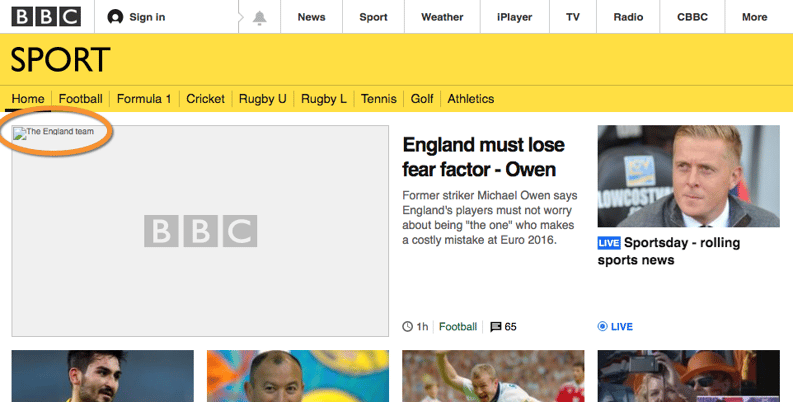
Get weekly
HubSpot updates
If you’re creating fantastic unique content that is answering your customers’ questions and providing real value, by taking some time to consider SEO you’ll be giving your blogs the best chance of ranking highly in the search engine results pages (SERPs).
The H1 tag
Important for reasons beyond SEO, your H1 tag - also your blog post’s title - is what's going to convince people they should read your blog in the first place.
With this in mind, you need to make sure your title is going to capture their attention. Check out our blog, 6 Steps to Writing Awesome Article Titles that Drive Traffic, for advice on how to structure your headlines to drive the best click-through rates.
In terms of SEO, it is vital that your H1 tag contains your focus keyword - the closer to the beginning of your title the better.
Page Title
Another important on-page SEO signal, your page title is what appears at the top of the browser window, and will typically be made up of your H1 tag and company name

The page title is also what appears in the search engine results pages. If it contains the keyphrase or part of a keyphrase that was searched for, it will appear bolded.
A Content Management System such as WordPress contains settings that will allow a page title to be generated automatically.
H2 tags
Although not as significant as the H1, H2 tags are still an on-page ranking signal that you can take advantage of.
Discover the blog formatting techniques that can boost user engagement.
Include your focus keyword in these subheadings where appropriate, while you can also use H2s to incorporate keyword synonyms into your blog posts.
Use keywords throughout
Once upon a time, the secret to getting your content ranking organically was to stuff it with keywords.
In 2016, things are not that simple, and the search engines are much more savvy when it comes to judging which content deserves to make it to the top of the SERPs and which doesn’t.
The benefit of this is that you can get on with writing your blog posts without worrying so much about including enough occurrences of your focus keyword. As long as the blog post is about the subject you want to rank for, it should include your keyword enough times naturally.
The one thing you should consider is trying to include the focus keyword as close to the top of the blog as possible, but again, this is something that nine times out of 10 will happen naturally anyway.
Optimise images
The primary reason you should be using images in your blog posts is to add a visual element that adds genuine value. In addition, images will break up the text that can be off-putting to a user when it is in uninterrupted blocks.
In fact, content with relevant images receive 94% more views than content without, while research has also found that content with coloured visuals is 80% more likely to be read.
They can also help search engines to more easily identify what a blog post is about.
There are two code-level elements to consider when uploading images to a blog post.
First, the source attribute identifies the URL where the images are located; instructing the CMS where to fetch them from in order to be displayed on the web page.
<img src="http://cdn2.hubspot.net/Blog_Images/4-things-to-be-wary-of-pitch.jpg" alt="4- things-to-be-wary-of-in-pitch.jpg" title="4-things-to-be-wary-of-pitch.jpg" width="730" height="486">
The alt attribute (commonly referred to as alt tag or alt text) provides an explanation to the search engine as to what the image represents. Alt is an abbreviation for the word alternative - hence why it displays if the image fails to load for any reason.
Check out this blog post from Venngage about getting more from your visual assets.

With this in mind, it is important that your alt tags accurately describe the image for both users and search engines.
The alt attribute is a very small SEO ranking signal, particularly for image search.
Internal & External links
Inbound links from websites with high Domain Authority are still the most important SEO ranking factor, but internal links (links from one page of your website to another) and external links (links pointing at other domains from your blog post) are also considered potential signals - albeit smaller ones.

In this example, users are directed to download one of our eBooks via an internal link.
Internal links help to pass link equity and authority around your whole website, while they can also be used to direct users to other relevant resources, as well as push them towards submission forms or product pages.
Including external links might seem counterintuitive - after all, why would you want to direct users to a website that isn’t yours - but linking out to relevant, useful resources can add real value to your content. What’s more, the search engines may start to deem your content a hub of useful information around the subjects you write about.
The Longer the better
Our attention spans are falling.
In fact, according to research they have fallen to just 8.5 seconds, compared with 12 seconds back in 2000. That’s even less than a goldfish!
With this in mind, you’d have thought that shorter form content would be the most successful, but it seems as though the opposite is true when it comes to SEO rankings.
A study of over 20,000 keywords found that long form content far outstripped shorter content in the organic rankings, and it’s backed up by Google:
“Users often turn to Google to answer a quick question, but research suggests that up to 10% of users’ daily information needs involve learning about a broad topic. That’s why today we’re introducing new search results to help users find in-depth articles.”
This doesn’t mean you should simply pad out your blog posts to up the word count. If content warrants a lengthy post then great, but if it’s a subject that can be covered in 300-500 words then that’s how many you should write. The search engines will recognise if your content is thin in terms of a lack of unique value - and so will the users.
The key thing to remember is that you should never rush to publish a blog post just because you feel you should be creating new content. Take advantage of every opportunity to optimise your posts as possible to give them the best chance of rising high in the organic SERPs.
It is no secret that providing content through blogging is a key tenant of SEO, not to mention that it is integral to the inbound marketing methodology. But all too often people publish content to their blog without taking the time to think about how best to optimise it for the search engines.
